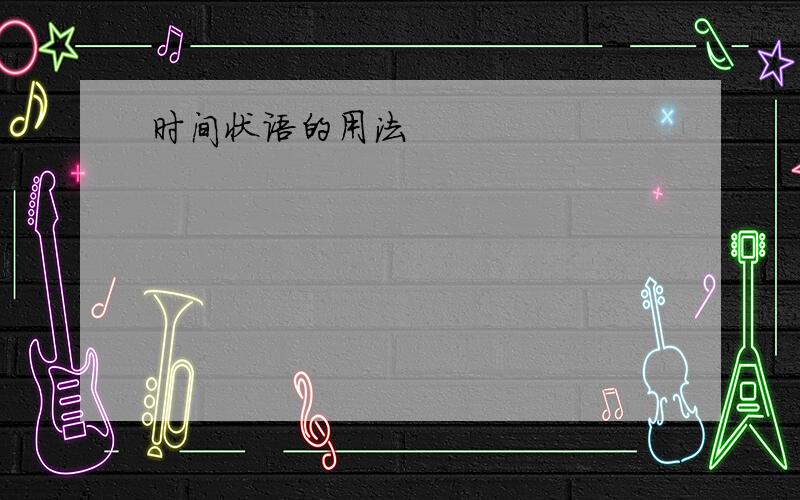时间状语的用法
来源:学生作业帮助网 编辑:作业帮 时间:2024/04/29 21:47:02

时间状语的用法
时间状语的用法
时间状语的用法
1. when、 as、 while引导的时间状语从句分析:\
(1) when引导时间状语从句时表示“当……的时候”, when既可以指时间段也可指时间点, 从句中既可用延续性动词又可用非延续性动词, 且动作既可和主句的动作同时发生又可在主句的动作之前或之后发生, 注意体会如下例句: I’ll call you when I get there. 我一到那里就给你打电话.// When the wind blows, all the doors rattle. 只要风一吹, 这门就吱嘎作响.// He stopped trying, when he might have succeeded next time. 他不再试了, 其实他可能下一次就成功.// When I came home my wife was cooking dinner. 我回家时, 妻子在做晚饭.
如果when引导的时间状语从句的主语与主句主语相同, 而从句的谓语又是be动词时, 那么从句中的主语和be可以省略; 当when引导的时间状语从句的主语与主句主语相同时, 往往还可以用“when+分词”的形式替代该状语从句.例如: When (you are) in trouble, ask her for help. 当你遭遇麻烦的时候去向她求助.// When I came into the room(=When coming into the room), I found him lying there asleep. 当我进入房间的时候, 我发现他躺在那儿睡着了.
(2) while引导时间状语从句时表示“当……的时候”, 它强调主句的动作与从句的动作同时持续地进行, 用于这一用法时while引导的时间状语从句和主句中的谓语动词必须是延续性动词, 或者主句的动作发生在从句动作的进行过程中, 主句中的谓语动词通常是非延续性动词, 例如: Study while you study; play while you play. 该学习的时候就学习, 该玩的时候就玩.// I met her while I was at school. 当我在学校的时候我遇见了她.
(3) as引导时间状语从句时表示“当……时, 一边……一边……”, 侧重表示两个动作同时发生(包括一个主语同时进行两个动作), 或者一种动作随着另一种动作的变化而变化.例如: He jumps as he goes along. 他边走边跳.// I slipped on the ice as I ran home. 我跑回家时在冰上滑了一跤.// I saw him as he was getting off the bus. 正当他下公共汽车时, 我看见了他.// As the wind rose the noise increased. 刮风的时候噪声增大.
2. before和after 引导的时间状语从句分析:
before引导时间状语从句时表示主句的动作发生在从句动作之前, after引导时间状语从句时表示主句的动作发生在从句动作之后.例如: See me before you leave. 在你离开之前来见我.// Before they drive any of the buses, they will have to pass a special test. 在驾驶公共汽车之前, 他们必须通过专门测验.// I saw them after I arrived. 在我抵达之后, 我见到了他们.// I found his pen after he has left. 在他走后, 我找到了他的笔.
3. till和 until 引导的时间状语从句分析:
till和 until这两个词作连词和介词时的意义和用法相同, 一般可以换用(放在句首时通常用until的形式, till在口语中更为常见).till和 until引导时间状语从句时跟主句里肯定形式或否定形式的、 表示延续性动作的谓语动词连用表示“到……为止”, 跟主句里否定形式的、 表示非延续性动作的谓语动词连用表示“直到……才(开始)”, 例如: Walk till you come to a white house. 一直走到一座白房子为止.// We didn’t discuss the problem until he came back. 我们一直等到他回来后才讨论问题.
4. since引导的时间状语从句分析:
since引导的时间状语从句表示“自从……以来”, 其用法主要有两种:
(1) 现在完成时的主句+since引导的一般过去时态的时间状语从句.例如: He hasn’t been home since he graduated. 他毕业后没回过家.// They have been friends ever since they were in grade school. 他们从小学起就一直是好朋友.// What have you been doing since I last saw you? 自我上次和你见面以后, 你在做什么?
(2) It be(主句中谓语用一般式和用完成式区别不大, 后者更具强调意味)+表示一段时间的词汇+since引导的时间状语从句.例如: It is two years since I became a postgraduate student. 我成为研究生已经有2年了.It was three years since we had been there. 我们在那儿已呆了三年.
注意: since做介词时也表示“自从……以来”, 其具体用法有两种情况:
(1) since+表示过去某个时间点的词汇(如具体的年、 月、 日期、 钟点).
例如: They have been friends since childhood. 他们从幼时起一直是好朋友.She’s been skiing since childhood. 她从幼时起就开始滑雪.I have been there many times since the war. 自那次战争以来, 我曾去该地多次.
(2) since+表示一段时间的词汇+ago.
例如: I have been here since five months ago. 五个月以来我一直在这里
表示客观真理、事实、人的技能或现在的状态时句子里一般不用时间状语。如:The earth turns round the sun.(地球绕着太阳转)/ Light travels faster than
可以通过介词短语 (如:at 6/ on Sunday morning /in the afternoon)也可以通过(when /while /before/ after/ as soon as /since等)引导的时间状语从句